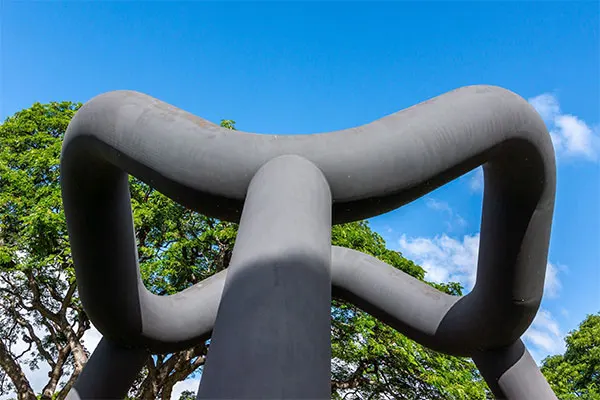Home to beautiful nature, deep history, and one of the only two regions in the US to produce coffee beans, Hawaii is a unique experience on its own.
And let’s not forget about Lahaina Noon: a one-of a-kind experience found only in select tropical areas like Hawaii.
What is Lahaina Noon?
Table of Contents
First of all, what the heck is Lahaina Noon?
Is it a particular time for tea? A festival? Nope.
Lahaina Noon is a tropical solar phenomenon that occurs twice a year, in May and July. During this phenomenon, the sun passes directly overhead sometime around local noon. And by directly, we mean directly—as in a 90-degree angle.
What Does Lahaina Noon Look Like?
Imagine this: You’re walking along, enjoying your time in beautiful Hawaii, when suddenly something seems off. No, it’s not a sudden change of weather. It’s something else. It takes you a moment to put your finger on it, but there it is! The shadows of objects are gone! Where did they go? What’s happening? Did you enter the world of Peter Pan where mischievous shadows like to wander off?
Fortunately, you don’t have to go chasing shadows to sew them back onto their proper spots. When the sun reaches this direct 90-degree point, something surreal happens: shadows disappear. Upright objects like a flagpole will have no shadow.
Why Is The Sun Directly Overhead In Hawaii?
No, it’s not magic or something supernatural, it’s simply astrological science.
This bizarre occurrence happens only in the tropics (they are near the equator, where latitude is 0-degrees). Other areas of the earth are too far from the equator for the sun to ever be directly overhead at 90-degrees, so this is something you’ll never experience outside the tropics.
It’s also worth noting that Hawaii is the only of the 50 United States to experience this phenomenon, since it’s the only state that exists in the tropics.
A Little Bit of History on Lahaina Noon
The name Lahaina Noon was coined in 1990 by the Bishop Museum. It roughly translates into “cruel sun,” a reference to severe droughts experienced in parts of Maui.
Historically, this was a time when certain cultural rituals were (and perhaps still are) planned. Shadows in many of these cultures represent the spirit. Lahaina Noon was believed by natives to be a time of great spiritual power, when the shadow retreated into the body.
In fact, shadows were held in such high regard that an aliʻi kapu (a high ranking sacred chief) would not let their shadow fall upon someone of a lesser status because such an interaction would have a negative impact on their own spirit. The same goes for someone of a lower status not letting their shadow cross that of an aliʻi kapu.
Lahaina Noon in Modern Times
Today, the event is still popular. Honolulu even erected a sculpture specifically for Lahaina Noon called Sky Gate. This sculpture features twists and turns forming a wavy elevated circular shape that, during most of the year, makes a twisted shadow on the ground.
At Lahaina Noon, this shadow becomes a perfect circle. Without the sun being at an angle, the waves simply don’t show up in the shadow.
And because you’re probably wondering, In terms of a person’s shadow, you’ll still see it. Sorry, no vampire shadow for you! However, it will be directly under you instead of cast off at an angle like we’re used to seeing. Still pretty cool.
How Long Does Lahaina Noon Last?
Another unique aspect of Lahaina Noon is that it’s relatively short-lived. Some people report it lasting up to an hour, though, so don’t feel too rushed to snap a ton of pictures in a super short amount of time.
It hasn’t been pinned to an exact time span, but it’s not so brief that you’ll blink and miss it.
As mentioned above, this phenomenon only occurs twice a year, in May and July. It’s also important to note that this happens at different times, depending on where you are in Hawaii. More on that below.
The Lahaina Noon in Hawaii—Where and When Can You Witness It?
If you’re concerned you might not be in a good area of Hawaii to experience Lahaina Noon, worry not! You can experience Lahaina Noon on all the visited islands. Fortunately, it’s not something you have to buy tickets for!
The Bishop museum has mapped out specific locations and times where you can experience Lahaina Noon no matter where you are in Hawaii. Check out this year’s Lahaina Noon times!
How to Make Sure You Don’t Miss the Lahaina Noon (Be Ready—It Doesn’t Last Too Long)
Like an eclipse, Lahaina Noon doesn’t last too long. Some report it lasting up to about an hour. To make sure you don’t miss it, check out the projected times and locations where you can experience Lahaina Noon.
Some islands, like Oahu have dedicated resources like the Sky Gate for you to experience Lahaina Noon. If you’re not in that area, look for straight up-and-down objects like poles. These are your best chance to really see the full effect of Lahaina Noon.
Each time is different and very specific, so make sure you’re in the area ahead of time and budget about an hour to take advantage of this phenomenon. You can look up some local attractions and eateries to make the most of your time in the area.
If You’re in Hawaii During Lahaina Noon, It’s Worth Witnessing this Phenomenon (and It Won’t Take Much of Your Play Time)
If you’re planning to be in Hawaii in May or July, it’s worth planning some time to experience Lahaina Noon. Remember, this doesn’t occur outside the tropics and in the States it only occurs in Hawaii, so for most of us, it’s a novel phenomenon.
Since it doesn’t last too long, planning time to witness Lahaina Noon won’t take too much time from your original itinerary. Plus, there’s bound to be local attractions, eateries, and more near the locations where Lahaina Noon occurs.
Make the Most of It

If you’re willing to travel a short distance, you can make it a day trip. For example, let’s say you’re staying in Maui, but really want to visit Sky Gate on Oahu, yet are hesitant about making a trip just for that. The good news is, there is plenty to do on Oahu.
It’s the location of historic Pearl Harbor, where you can learn about the event and take a look at memorabilia, as well as real naval ships.
Also on Oahu is Diamondhead, a dormant volcano. If you’re able and up for it, you can hike this massive volcano for an awesome view of Honolulu, Waikiki beach, the expansive ocean, and the gorgeous hills of the island.
In addition to that, Oahu is home to the Dole Plantation. So after Lahaina Noon, make a trip from Honolulu over to Wahiawa and learn all about pineapples!
You’ll be able to see how they’re actually grown, taste fresh pineapple, buy pineapple candies (and pretty much pineapple-flavored everything), and maybe pick up some souvenirs.
When you return home, you’ll have some interesting photos to share with friends of poles with no shadows, an incredible view of the island, a critical location in American history, and maybe you’ll even have some pineapple candy to share!
Other Places on the Planet That You Can Witness the Lahaina Noon
Of course, Hawaii isn’t the only place located in the tropics. Although perhaps not called Lahaina Noon in other areas, the phenomenon occurs in pretty much every other place located between 23.5 degrees north latitude and 23.5 degrees south latitude. These degrees of latitude are better known as the Tropic of Cancer and the Tropic of Capricorn.
Outside of the States, the Lahaina Noon phenomenon occurs in places like the Philippines, Singapore, and Nicaragua. So if you’re planning to be in any of these areas instead of Hawaii, you can still take advantage of the experience.
Although small compared to many of the larger US states, Hawaii is jam-packed with fun things to do, interesting history, great food, and cool phenomena. Nowhere else in the States can you experience Lahaina Noon, ultra-fresh pineapple, and amazing history. Be sure to block out some time for Lahaina Noon in your Hawaii itinerary!
